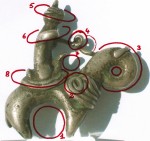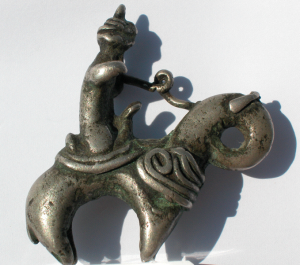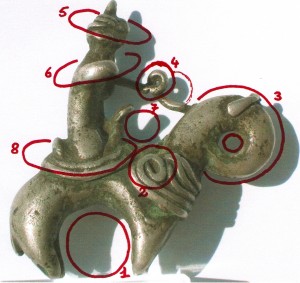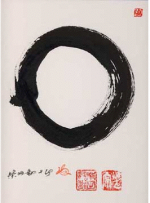Milano. Dinner at the house of friends.
Tommy doesn’t like the paella. He’s never been to Spain.
I don’t like this paella either. I lived a long time in Spain.
So while the others stay at table, Tommy and I sit together in front of the monitor of Tommy’s grandfather.
On my web-site, Tommy immediately likes the horse and rider about which I say :
it’s the loveliest I’ve ever seen.
Tommy doesn’t let you declare anything without politely asking you why.
In fact, he asks: “Why do you say that this soldatino, little soldier (that’s what he calls him) is the loveliest one?”
That’s not easy to explain to a five-year old.
And it’s especially not easy to explain verbally a sensation that is completely visual and tactile.
But Tommy has serious probabilities of being a soccer champion some day:
he’s already in the Pulcini del Milan team (Italian Little League Soccer). So he owns, thoroughly knows and loves a soccer ball.
So I say to him : just like everything in your soccer ball is round,
this ‘little soldier’ is so lovely to look at and so sweet to touch because everything about him is round.
We print a photo together. Then using a red felt-tip pen we start discovering how this little sculpture –
primitive, for some even uncivilized – is in reality an incredibly refined orchestration of variations on the theme of a circle.
Obviously I don’t talk to Tommy like this. However, our discoveries with the red pen seem to convince him.
So it seems right to me to also report the explanation I gave to Tommy on this site, where the visits of children are most welcome
and the comments of all children from 5 to 105 years old are especially appreciated.
Let’s pick up our metaphorical soccer ball. Ball to the centre circle.
What dictates the leitmotif of the circle is the perfect arc (1) designed by the front paws hoofs, the belly and the rear hoofs of the horse.
Let’s go up a bit towards the right and, there it is, a spiral that closes in a circle (2) the harness on the horse’s chest.
We’ll continue up, to the right. The horse’s head designs a perfect circle (3). And what’s more, the shadow doubles it.
Now, from the horse’s head to the left, towards the horseman: the reins design a small, gratuitous, terribly elegant arabesque (4)
that encloses a round point of light in a perfect circle. And the shadow also echoes here.
From the reins upward, towards the horseman’s turban : it spirals (5) to create a round volume –
that suggests a new space, perpendicular to a reading which up to now has only been in profile.
Another circle (6) designs the short, stylized arms that extend into the horseman’s back.
Moving downward and to the right the arched structure of the saddle stands out like an erect member
and suggests another circle (7) that loses itself in the space between the reins and the neck of the horse.
A bit lower, conquering another all around space, parallel to the space of the turban and the arms,
there is the circle (8) drawn on the horse’s body of by the circular saddle cloth.
From here to the perfect arc (1) the circle of the discovery of circles closes and re-opens with an elegant and infinite movement.
An all around accompanied by light, re-echoed by shadows; one looks at and caresses it like a single melody
that always develops newly and always returns equal to itself: always the same and always different.
A great man (Plinius the Elder) wrote:
“Africa always brings us something new”.
Two thousand years later, another great man (H.W.K.Collam) confirms:
”Africa’s past is always a step ahead of Europe’s present”.
In this minute masterpiece of the horse and horseman Kotoko (collected by Gérard Roso
between 1979 and 1984 on site in the Tildé Goulfey region of northern Cameroon)
everything is round and always round in a different way.
I don’t know (but I think yes) if the artisan, who drew, then modelled and then fused this pocket monument,
had consciously planned to make infinite and very personal variations on the theme of a perfect circle.
I don’t know if it’s a small and completely random miracle of elegance and harmony,
or if it is instead an incredibly refined elaboration of variations on a theme, like Johann Sebastian Bach’s ‘Goldberg Variations’.*
*For those who like reading to background music, for this article I’d advise listening
to the ‘Goldberg Variations’ in two very different executions by Glenn Gould,
the first in 1955 and the definitive performance in 1981.
This pocket monument is a miracle. Deliberate or casual ?
We could put the question to Giotto of Bondone with his “O”- a lightning and definitive debut.
For Tommy, here is a nice transcription of the episode known as “the O of Giotto”:
One day Giotto returns to his painting studio and is surprised to find a richly clothed man walking among the easels and paintings and observing them carefully.
The stranger approaches the painter and says: “His Holiness, Pope Benedict XI, wishes to decorate the basilicas of Saint Peter and Saint John with large paintings. However, he has not yet decided to which painter he will entrust this very important assignment.
I come in the name of the Pope to ask you for one of your works .. the best one. I shall take it to Rome along with the works of many other artists. The Pope will choose the loveliest among all these paintings and call its maker to decorate the basilicas. Which of these is your masterpiece?”
Instead of taking the best of his paintings off the easel, Giotto lays out a large sheet of white paper.
Then he dips his brush into the bottle of red and in a flash draws a circle so perfect it seems made with a compass.
“Here’s my best painting!”- says Giotto, giving the sheet to the Papal dignitary.
“But! You want me to take this “O” to His Holiness?” – the Pope’s ambassador exclaims amazed and offended.
“You really have nothing better to give me ? Or maybe you want to pull my leg?!”.
“No, Monsignor – Giotto replys. I really have nothing better to give you. But I am certain that this “O” will please the Pope.”
And after some days in fact, Giotto receives the happy news that he is the one who has been choosen among all the Italian painters.
The Pope had understood from that simple circle – from Giotto’s “O” – the man’s genius and the perfection of his art.
(adapted by Guido Petter, in “Racconti per un anno” (Tales for a Year). Firenze Giunti 1966)
This horse and horseman pocket monument is a miracle. Deliberate or casual?
We could put that question to the Zen monks who exercise every day for years and years
just to arrive one day at swiftly drawing, with one stroke of the brush, the circle they call “Enso”.
The deliberately imperfect circle of an “Enso”- apparently always the same and instead always with infinite variations – represents the Absolute, the Illumination, strength and elegance together. It represents the entire Universe
and the absolute Nothing. It’s only round, but all around.
Finally, we could put the question to Tommy
who from the height of his 5 years of wisdom,
still uncontaminated by the castration of schooling and television ‘aesthetics’,
approves my pathetic efforts and declares:
“You’re right. It’s really lovely. Lovely as when I make a goal!”.



